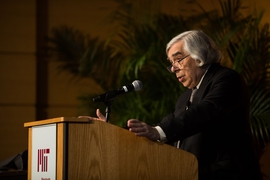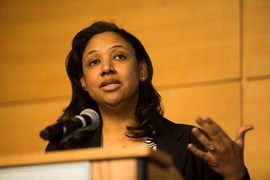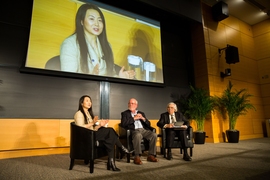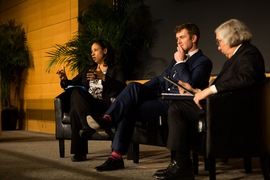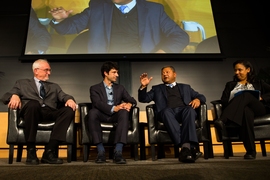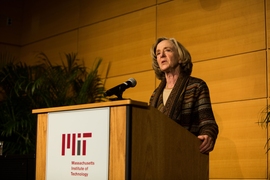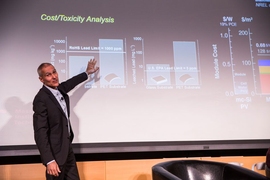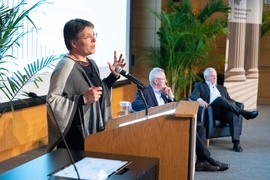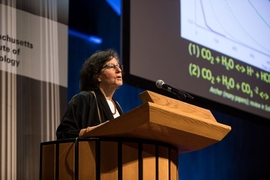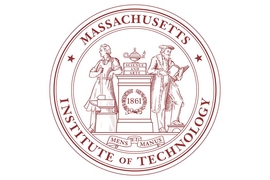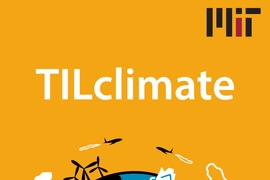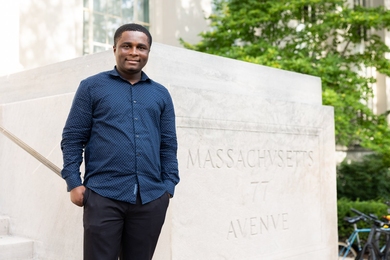How can the world cut its greenhouse gas emissions in time to avert the most catastrophic impacts of global climate change? It won’t be easy, but there are reasons to be optimistic that the problems can still be solved if the right kind of significant actions are taken within the next few years, according to panelists at the latest MIT symposium on climate change.
The symposium, the fourth in a series of six this academic year, was titled “Economy-wide deep decarbonization: Beyond electricity.” Symposium co-chair Ernest Moniz explained in his introductory remarks that while most efforts to curb greenhouse gas emissions tend to focus on electricity generation, which produces 28 percent of the total emissions, “72 percent of the emissions we need to address are outside the electricity sector.” These sectors include transportation, which produces 29 percent; industry, which accounts for 22 percent; commercial and residential buildings, at 12 percent; and agriculture, at 9 percent; according to 2017 figures.
While many commitments have been made by nations, states, and cities to zero out or drastically cut their electricity-related emissions, Moniz pointed out that in recent years many places, including Boston, have expanded those commitments beyond electricity. “We’re now seeing economy-wide net-zero goals in cities, including Boston,” said Moniz, who is the Cecil and Ida Green Professor of Physics and Engineering Systems Emeritus at MIT and a former U.S. Secretary of Energy.
As the generation of electricity continues to get cleaner, he said, the next step will be to extend electrification to other sectors such as home heating and heavy transport. Then, to deal with the remaining sources that are too difficult or expensive to decarbonize, technologies to remove carbon from power plant emissions or directly out of the air will be needed. Such carbon dioxide removal technology will be essential, he said, to provide enough flexibility in planning for climate change mitigation.
The symposium, held Tuesday in MIT’s Wong Auditorium and webcast live, was divided into three panels, addressing decarbonization of the transportation system and industry, development of low-carbon fuels, and large-scale carbon management including carbon removal from the air.
While electrification of passenger cars has been accelerating in recent years and is expected to increase dramatically over the coming decade, other parts of the transportation system such as aircraft and heavy trucks will be more difficult and take longer to address.
MIT professor of mechanical engineering Yang Shao-Horn described progress in increasing the amount of energy that can be stored in batteries of a given weight, a technology that will be crucial to enabling solar and wind power to produce an increasingly large share of electricity. With many new models of electric vehicles entering the market now, that industry “is experiencing explosive growth,” she said; the number of electric vehicles on the road is expected to grow a hundredfold over the next decade.
Lithium-ion batteries have become today’s standard for energy storage, and the amount of power they can store per pound has improved tenfold over the last 10 years, Shao-Horn said. But further progress will require new battery chemistries, which are being pursued in many labs, including her own. Researchers are exploring a variety of promising avenues, including metal-air batteries using Earth-abundant metals. For some applications such as aircraft, however, batteries may never be sufficient. Instead, cost-effective ways of using carbon-free technology to make a liquid or gas fuel, such as hydrogen, will be needed. “Development of such fuels is still in its infancy,” she said, and requires more research.
John Wall, former chief technology officer for Cummins, one of the world’s leading makers of diesel engines for heavy vehicles, said that after 100 years in business, that company last year introduced its first electric truck. But what’s really needed, at least in the near term, he said, are carbon-neutral “drop-in” fuels that can be used in existing vehicles with little or no modification.
Wall said that battery technology has reached or will soon reach a point where electrification of heavy vehicles “is credible up to urban class-7 trucks,” which encompasses most vehicles smaller than 18-wheeler tractor-trailers and heavy dumptrucks. But there are limitations, he said, such as the fact that city buses must be able to complete their daily scheduled routes without needing to be recharged, which at this point means many of them would require a backup power source such as a fuel cell.
Symposium co-chair Kristala Prather, the Arthur D. Little Professor of Chemical Engineering at MIT, addressed what is needed to develop low-carbon alternative fuels from biomass. She pointed out that biofuels have been controversial, and many pilot programs for biofuels, such as incentives for ethanol made from corn, have had disappointing results and fallen well short of their production goals. Given that poor track record, “Why are we still talking about biofuels?” she asked.
She is still optimistic about the potential of biofuels, she said, even though there remain many challenges. For one thing, the raw materials to produce fuels from biomass are abundant and widely distributed. “We have the biomass to be able to make this transition” away from petroleum-based fuel, she said. “You can’t make something out of nothing, but we have the something.”
She said that the tools of biotechnology can be applied to improving or developing new processes for harnessing microbes to generate fuel from agricultural products. These products can be grown on marginal lands that would not be suitable for food crops and thus would not be in competition with food production.
But there are still challenges to be worked out, such as the fact that many of these processes produce toxic byproducts that require disposal or that may interfere with the production process itself. Nevertheless, with active research ongoing around the world, she said, “I do remain optimistic that we will be able to produce biofuels at scale, but it’s going to take a lot of ingenuity.”
Francis O’Sullivan, an adjunct professor at MIT’s Sloan School of Management and senior vice president for strategy at the wind energy company Orsted Onshore North America, said hydrogen could provide an important bridge fuel as the U.S. and the world work to decarbonize transportation. But he pointed out that not all hydrogen is created equal. Most of what’s produced currently is made from fossil fuels through a process that releases carbon dioxide. Efficient, scalable electrolysis systems will be needed to produce hydrogen using just water and electricity produced from clean sources.
In the power sector, he said, “there is a significant role for hydrogen, in concert with renewables,” for example in transportation and in industrial processes. Though there are many issues to be solved in terms of efficient storage and transportation of hydrogen, “it does allow us a lot of flexibility, and therefore is a pathway worth exploring.” And there is progress in that direction, O’Sullivan said. For example, the U.K. is currently building a 100-megawatt electrolysis plant to produce hydrogen, powered by offshore wind turbines. But currently such projects would not be feasible without government subsidies.
Howard Herzog, a senior research engineer at the MIT Energy Initiative, said that about 30 percent of the world’s total greenhouse gas emissions comes from sources that can be classified as “difficult to eliminate.” Therefore, developing ways to capture and store carbon, either at the emissions source or directly out of the air, will be essential for meeting decarbonization targets. The easiest way to do that is at the emissions-producing plants themselves, where the gas is much more highly concentrated.
But direct air capture may be the only way to clean up those emissions that come not from energy sources themselves but from certain production processes. For example, cement production releases as much carbon dioxide from the limestone being heated as it does from the power to provide that heating. But though direct air capture is “a very seductive concept,” he said, achieving it “is not that easy.”
“The question is not whether we can get carbon dioxide out of air — we do it today. The real question is the cost,” Herzog said. While estimates vary, he says the true cost today is around $1,000 per ton of carbon dioxide removed, and to be truly competitive it would need to be about a tenth of that. Still, some pilot plants have been built, including one in Texas that can capture 1.6 million tons of carbon dioxide per year.
Ruben Juanes, a professor of civil and environmental engineering at MIT, discussed ways of dealing with the carbon dioxide that gets captured by these methods. A number of different processes have been proposed and some have been implemented, including the use of depleted oil and gas wells, and deep underground saline aquifers — formations deep enough and salty enough that nobody would ever want to use them as water sources.
“They are ubiquitous. They provide a gigantic capacity that is available at scale,” he said.
But because the scale of the problem is so big, there still remain challenges, such as getting the carbon dioxide from its source to the underground storage location. The amount of carbon dioxide involved is comparable to the total amount of petroleum currently distributed worldwide through pipelines and supertankers, and so would require an enormous creation of new infrastructure to move.
While that may not be an ultimate solution, “we can think of this as a bridge technology” to use until better systems are developed, he said. “If we want to make good on our efforts” to eliminate global greenhouse gas emissions, “we need to have that bridge.”
Arun Majumdar, a professor at Stanford University and formerly the founding director of the Advanced Research Projects Agency for Energy (ARPA-E), said that overall, “this is a gigaton-scale problem,” and that in order to have any chance of meeting the international target of keeping global warming below 2 degrees Celsius, we would have to limit total global emissions from now on to the equivalent of 800 gigatons of carbon dioxide. That means that at emissions rates of 40 gigatons a year, “we only have 20 years left” to use fossil fuels. So any solutions, to be viable, need to be capable of working at gigaton levels.
That’s still just a small fraction of the amount of carbon going in and out of the air through natural carbon cycles that have been “in balance for millions of years,” he pointed out. “They’re now thrown out of balance.” But therein may lie some potential solutions. For example, the amount of carbon that gets sequestered in the ground by growing plants is strongly dependent on their root depth, and developing crops with deeper roots could provide food and carbon sequestration at the same time. “I want to grow mega-carrots!” he said, putting a humorous spin on a serious proposal that he outlined in detail in a recent research paper.
But predicting the outcome of any of these possible countermeasures is daunting, partly because so many aspects of the climate system remain poorly understood. For example, melting of permafrost in the northern landmasses could result in sudden, large releases of methane, a very potent greenhouse gas. “We really need to look into it,” he said, because so far, “none of the climate models capture it,” and thus they could be understating the severity of the climate challenge. He suggests an urgent need for more research on potential materials that could selectively absorb methane.
Majumdar said that the target increase of 2 degrees “is kind of baked in” already, and that we should be prepared for the possibility of an actual average temperature rise this century of something like 3 to 3.5 degrees. “We should be looking at options” for dealing with such extremes, including the controversial possibility of geoengineering projects to try to limit the amount of sunlight reaching Earth’s surface.
Herzog added that any measures we can take today will be far more cost-effective than what we may have to do in later decades. “It costs $20, $30 or $40 a ton to keep carbon dioxide out” of the atmosphere today, he said, but if we leave the task to future generations, “to take it out of the air will cost hundreds of dollars a ton.”
Majumdar said that though the challenges are daunting, they also represent a golden opportunity for research. “I do believe science and engineering and technology can play a role” in solving the problems, he said. In fact, he said, he wishes he were a student just starting out today, with so many areas where research could play a major role in addressing these global needs. “I wish I was a freshman,” he said. “You want to solve problems? This is a big one!”
